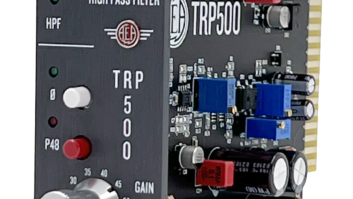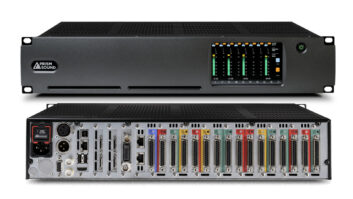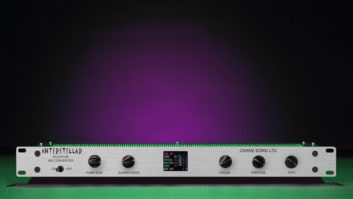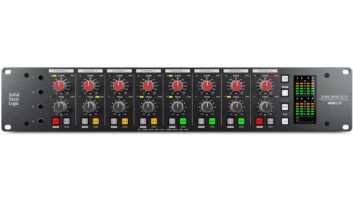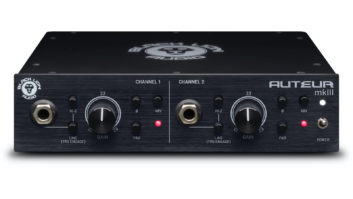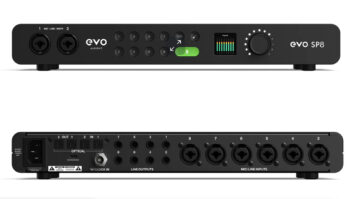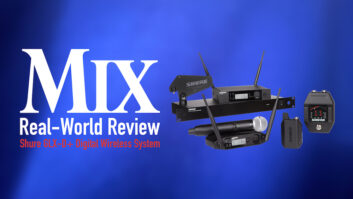
The world is full of sound cards and other digital Lightpipe-capable devices waiting to be unlocked to the analog realm. M-Audio has answered that need with Octane, an affordable unit with eight mic and line inputs and ADAT digital outputs.
ONCE OVER
The 2-unit Octane is a fairly hefty box, considering that it’s only 5¼ inches deep — not counting the 2-inch heat sink fins on one side — and uses a large 18-volt AC/3,500mA in-line external power supply. Its controls feel decidedly smooth and solid, and it has a semi-precious blue LED power-on light, which happens to be bright enough to read by.
Each of its eight channels has a mic input with 50 dB of continuous gain, a three-LED meter, a 20dB pad and phantom power that can be switched in groups of four channels. Only channel 1 has a low-cut filter, and the first two channels have active hi-Z front panel instrument inputs with individual gain controls.
All of the even channels have polarity reversal switches, which is a very intelligent compromise compared to having them on all eight channels. If you’re miking in stereo, you obviously don’t need to reverse both channels. However, if you’re using more than two mics on a source, such as when miking a drum kit, you can usually swap cables if you need to reverse a mic that is plugged into an odd channel. Slipping tracks by tiny increments in a DAW is a much more refined way to phase-align tracks anyway.
Channels 7 and 8 have an M/S decoding matrix with width control, an excellent feature. On the rear, every channel has a balanced TRS post-preamp send jack that’s normalled to a balanced return/line-in jack beneath it, but both are happy with unbalanced signals, as well. These connections can be used as send/return loops for routing mic signals through external signal processors, or instead of returns, you can plug in line-level signals to be converted to digital.
This post-preamp signal routing scheme may seem obvious, but it should not be taken for granted. A lot of mic preamp/digital converters either don’t provide send/return loops or just pad down the mic inputs for line-level signals. While the effect is often negligible, extra gain circuitry lowers the noise and distortion specs to some degree.
Most budget units, including nearly all project studio — priced mixers, use a single TRS jack for unbalanced send/return loops. Octane is decidedly more pro in this regard. The Octane operates at 44.1 and 48 kHz. It has word clock in and out — another feature not to be taken for granted in a device in this price range — and ADAT optical out.
BUDGET UNIT, SOLID PRODUCT
I auditioned Octane with its word clock output driving a MOTU Digital TimePiece (DTP), which routed digital sync in various formats to the rest of my studio. In another test, slaving Octane to the DTP didn’t have a notable effect on the recorded sound. This implies that Octane’s clock recovery circuitry is up to snuff.
To hear Octane’s mic preamps, I set up a pair of Oktava MK012 cardioid condenser mics and recorded acoustic guitar, cello, alto recorder and male-magazine-writer-attempting-to-sing into Pro Tools via a 24-bit ADAT bridge. I also isolated the Octane mic preamps by recording from one of its preamp outs into a digital mixer, after which, I isolated its A/D converters by plugging a line-level signal into its line ins.
Octane’s analog circuitry is extremely quiet and its A/D converters — isolated from the mic preamps by listening to the unit’s line ins — sound as good as the digital mixer and better than the first-generation FireWire audio interface that I compared them to. Especially when you’re listening to 2-track recordings rather than eight channels, the differences are pretty subtle. In my experience, there’s a very short window in which you can hear them clearly, after which the brain seems to have determined that it all sounds the same.
Having determined that the A/D conversion passes muster, I isolated Octane’s mic preamps by listening to the rear panel send signal. They sounded just fine. Of course, at under $94 a channel, you’re not going to hear as much information about the room you’re in as if you were using higher-end preamps. Also, 50 dB of gain is only just enough if you’re using dynamic or ribbon mics from any distance. But these mic preamps are perfectly usable — another characteristic not to be taken for granted in a budget unit.
Octane is a solid product with a good collection of features and a good value. Anyone with a vacant ADAT digital input would do well to try it out. Price: $749.95 MSRP.
M-Audio, 626/633-9050, fax 626/633-9070, www.m-audio.com.
Nick Batzdorf is an L.A.-based music and audio technology writer, composer, engineer, producer and musician.
